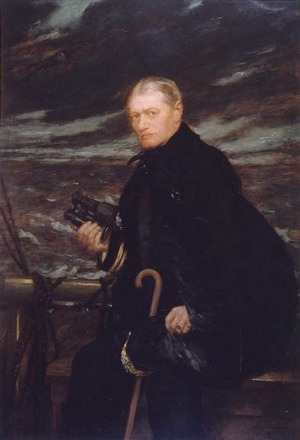

Naval History & Heritage Command photo NH 86163 KN.
RAdm. Robley D. Evans, USN, by August Franzen.
Evans distinguished himself during the ground assault on Fort Fisher, North Carolina in mid-January 1865 but was badly wounded. His injuries, which troubled him for the rest of his life, led to his retirement in May 1866, but he was returned to active duty in the rank of lieutenant early in 1867. During the later 1860s and into 1870 he served in USS Piscataqua (renamed Delaware in 1869), flagship of the Asiatic Fleet, and was promoted to the rank of lieutenant commander during that time.
Following shore duty at the Washington Navy Yard and at the Naval Academy, he returned to sea in mid-1873 for over two years’ service in the European Squadron, initially in USS Shenandoah and later in USS Congress. Evans then had another assignment at the Washington Navy Yard, during which he worked with signal technology. In 1878–1880 he was commanding officer of the training ship Saratoga. Over the next dozen years, Commander Evans primarily had assignments as a lighthouse Inspector and member of the Light-House Board, but in 1891–1893 he went to the Pacific as Commanding Officer of the gunboat Yorktown. His determined conduct during the 1891–92 crisis with Chile won him the popular nickname “Fighting Bob,” and his reputation was further enhanced later in 1892 by his energetic efforts to stop illegal seal hunting off Alaska.
Following promotion to captain in June 1893, Evans had further Light-House Board service and, in 1894–1897, commanded the armored cruiser New York and the new battleship Indiana. During the Spanish-American War, he was given command of the battleship Iowa and performed splendidly during the 3 July 1898 Battle of Santiago. He was assigned to the Board of Inspection and Survey from October 1898 until early 1902 and was its President after his February 1901 promotion to the rank of Rear Admiral.
Rear Admiral Evans commanded the Asiatic Fleet in 1902–1904 and, beginning in March 1905, the Atlantic Fleet. In late 1907 and early 1908 he led a large force of battleships around South America to California on the first leg of the “Great White Fleet”’s historic cruise around the world, but ill health forced him to relinquish his post in May 1908. Though retired upon reaching the age of 62 years in August 1908, he had a few years of further service in association with the Navy’s General Board.
Rear Admiral Evans died at Washington, D.C. on 3 January 1912.
DD 78 and DD 552 were named in his honor.